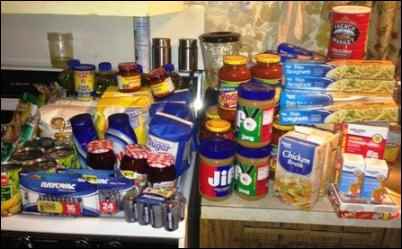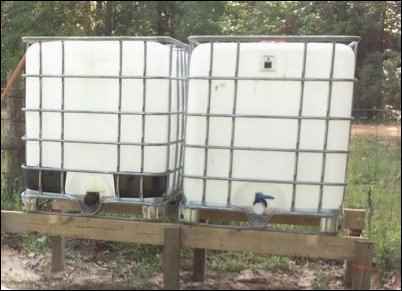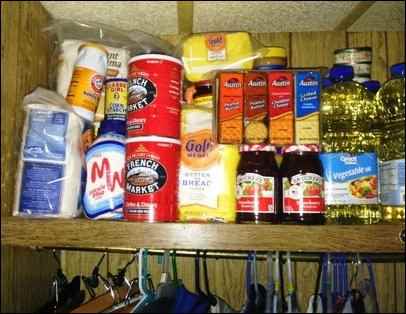As a homesteader and a prepper, I believe in having stored food. However, there’s the smart way to do it and the dumb way to do it. I have done it both ways and I’m smarter now than I was before. Not only do I practice emergency food storage, but I have used all my emergency food storage on more than one occasion.
The dumb way to store food is to run to Costco (or Walmart) and buy big institutional-sized peanut butter, sugar, flour, etc. The mistake here is buying “bulk” quantities. A 5-pound tub of peanut butter is too much if you are making a couple of sandwiches a day. It’s hard to keep large quantities of food fresh once you open them—especially if you don’t have refrigeration. My recommendation is to buy 5-6 small jars of peanut butter instead of one large one. The same goes for flour, oil, etc.

Another dumb way to store food is to run online and order 250 pounds of “Hard Red Winter Wheat” or go to Costco or Walmart and buy large bags of dry beans and raw rice. Then put all these things into 5-gallon buckets. The mistake here is buying food you don’t already eat or buying food in formats that you have no idea how to use. I can use flour. I have no idea how to use “Hard Red Winter Wheat”. Yet, when I started prepping I did have 200 pounds of hard red wheat in my storage closet. I have since thrown it away. If you don’t already eat beans and rice regularly, don’t base your food storage on it.
Another dumb way to store food is to head to the survivalist store (or online) and order $1,500 worth of freeze-dried food. Freeze-dried food stores for a long time and it can be a good part of your long-term emergency storage. I have freeze-dried and dehydrated food as part of my prep. The biggest issue with freeze-dried and dehydrated food is the amount of water they require to prepare. In an extended electrical outage, water stops flowing. Freeze-dried food uses lots of water. If you are going to use these foods you need to have a rock-solid water storage plan as well.
If you are buying dehydrated/freeze-dried food here are a few observations:
- Try a little before you buy a lot.
- Auguson Farms is an inexpensive brand that you can often order directly from Walmart.com cheaper than if you go directly to the company’s website.
- Auguson “Complete Meals” may sound like a good option, but try them first. To me some are inedible
- It’s just as cheap to buy the items individually, so don’t think you need to purchase a mega-package to save money. Also, the mega-package may have items that you won’t use, like Hard Winter Wheat.
- Read the reviews. If everyone says it’s inedible then don’t buy it—even as part of a package.
- You may find it just as easy to buy Knorr Side Dish (pasta or rice) packages for $1.25 each and store them as it is to have a big #10 can full of “Cheesy Rice Soup”. Knorr side dishes last two years minimum and store very easily.
Food is a combination of three things: Nutrition, Water, and Energy.
If you pick a heavy, prepared food like a can of Campbell’s Hearty Chicken Soup then it already has everything packaged into the can: nutrition, water, and energy. You don’t need to cook it or hydrate it. You can just eat it right out of the can. Peanut butter, trail mix, boxed cereal, crackers, canned tuna. These are your traditional “emergency” foods. They require no preparation or water. However, they are bulky and often have shorter shelf lives.
Next on the list are foods that just require water. Powdered milk is a good example. Or foods that require some water and minimal energy. Some dehydrated and freeze-dried foods fall squarely into this category. But you need to read the cooking instructions to be sure. Some need to be simmered for 15-20 minutes. If you are trying to eat the lowest-energy-need food look for food that just requires you to add some boiling water to the pouch. These are generally found in backpacking stores. This type of food is the most expensive per serving.
Finally, are foods that require both water and lots of energy. This is the big mistake of choosing rice and beans in particular as a food storage staple. Rice requires boiling water PLUS twenty minutes to cook. Most dry beans require at least an hour to cook. Dry beans that have been in storage for a year or more require more time to cook than usual. On the plus side, they are cheap and easy to store.
When the lights go out and the water (potentially) stops flowing what will you eat? If you need water and energy to prepare your food, where will it come from?
3.1 Layers of Emergency Food Storage
I use 3.1 layers of food storage. Layer 1 is extra of everything that I normally eat. Layer 2 is the storage of bulk normal food items that I can make without electricity but with the propane that we have on the farm. Layer 3 is “exotic” food storage such as freeze-dried and dehydrated foods that I normally don’t eat but will save my family if we need them.
What’s the .1 part of 3.1 food storage? The “point one” is my “bug-out food”. This is food, water, and other supplies that I can throw into the back of a car for my family to live on for at least 72 hours. My go-to source for this is military-style MRE’s along with a couple of cases of bottled drinking water and a 5-gallon water “cube”.
Emergency Food Storage Layer 1: Extra of Everything
Layer 1 is easy and anyone can do it. Instead of buying one can of tuna, buy two and put the extra one in the closet. It’s super easy. Since it’s food you were going to buy eventually, it costs nothing more than you would spend anyway. Plus it makes life easier. When you run out of cereal you just go to the closet instead of the store. I tend to keep two or three extra of most foods that we regularly eat. This is also true of cleaning and paper products. Just buy an extra one and put it in the closet. You’ll never worry about toilet paper again.
Emergency Food Storage Layer 2: Electricity-free Stockpile
What can you cook without electricity? If you have a gas stove, you can use your stovetop to cook, but you cannot use your oven because all gas ovens use electric start and electric gas flow control. So, without electricity, your oven will not work. Do you have a propane grill? Keep extra propane on hand.
As far as food is concerned, what will you reasonably eat in a month that you can store with no electricity and prepare with the energy you keep on hand? Only you can answer that. I stick with food that I will eat even if there is no emergency. I avoid “prepper” food that my family won’t eat (massive quantities of beans and rice). I like storing plenty of dried pasta, jars of spaghetti sauce, flavored rice meals and pasta meals, large cans of chunky soup. Peanut butter and jelly are good if you also store crackers or have a way to make bread… and store flour, oil, and yeast. I also store plenty of canned meat. I prefer to can my own, it’s cheaper.
Canning your own meat is cheap, easy, and fun. Start with cheap chicken leg-quarters. Sometimes they are on sales as low as thirty-nine cents per pound! When that happens, I buy 100 pounds and spend two days canning chicken.
Emergency Food Storage Layer 3: The Long Emergency
If you are like me and enjoy going “through the looking glass” then you might want long-term food storage. The chances of ever needing long-term food storage, in my opinion, is easily less than 1%. Money spent on long-term food storage is almost certainly money wasted. But it’s worth it to me for the peace of mind.
If you are going down the rabbit hole and preparing for a long emergency like an EMP, solar flare, financial collapse, pandemic, etc. then you don’t need my advice.
Most people don’t know that if you go to Walmart.com and search for emergency food storage you will find great deals on food storage. I believe it is better to look at what’s actually in these “mega-packs”, decide what you will eat or won’t eat, and then buy your own version item by item. You would think it’s more expensive, but really it isn’t.
I did a cost comparison of the “1 person 6-month” pack which costs $410 and took out the items I won’t eat: such as hard white wheat and imitation meat substitute. Buying the items individually without the junk I just won’t eat ended up costing $211 instead of $410. I can use the extra $199 to replace them with items that I will actually eat. In this case, almost half the cost of the “mega pack’ would have been wasted.

Water
If you’re going to store food then you must store water and lots of it. A male in a temperate climate needs 3 liters of water per day. A woman needs 2.2 liters. That’s minimum. I prefer to store 2 gallons of drinking and cooking water per person per day. For my family of 3, that’s 42 gallons per week. The easiest solution is blue plastic barrels. Each will hold 42 gallons of water. They keep contaminates and light out so the water will stay fresh and clean indefinitely. You can buy new barrels from U-line for $55 or used barrels from Craigslist for $20 each. The math is simple: one barrel will only provide one grown man with about 2 months of MINIMAL drinking water. If you live in an apartment and don’t have room for something this big then just buy lots of 1-gallon or 5-gallon water jugs and stack them on shelves in the closet.
Keep at least 1 gallon of UNSCENTED bleach in your storage plan. Just a few drops of bleach can disinfect a gallon of drinking water. Your municipal water supply cleans the water with chlorine. That’s the same thing that’s in basic unscented bleach. This will allow you to collect rainwater and purify it.
I, personally, use IBC Totes. IBC stands for “Intermediate Bulk Container”. They are standard liquid shipping containers. If you use one for drinking water you want “food grade” that didn’t contain anything that would contaminate your water supply. I purchased two IBC Totes for $160 from Craigslist. My two IBC Totes will store 550 gallons of emergency water for my family—105 days of drinking and cooking water.
Other Considerations
Lots of batteries, candles, and flashlights; cleaning supplies and paper products; personal hygiene; cash; medicine; first aid; disinfectant; extra copies of paperwork; passports; fuel storage; home defense.






“Major thankies for the blog post.Really looking forward to read more. Will read on…”
Thanks! Tony
Good luck finding chicken, even on sale, for 39 cents a pound, but, still, lots of good information here. I’m not a prepper, but it doesn’t hurt to stock a little extra for an emergency, and with inflation being what it is, you’ll save money by buying ahead at today’s prices.
haha. yes, but believe it or not at my local Walmart right now a 10 lb bag of chicken leg quarters is $4.38. So they have gone from 39 cents a lb to 44 cents. The thing about leg quarters is that nobody wants them and every chicken has 2. Right now Sams Club has chicken thighs for about 95 cents when you buy them in bulk. I’ve also taken to canning brisket (believe it or not). There’s lots of good fat that can be cut off and stored for cooking. And canned brisket is super soft and tasty. Brisket is about $3.88 per lb at Sams Club, but it’s the cheapest beef product available. Pork butt at Sams runs $2,23 per lb in bulk.
My preference is still Chicken Thighs from Sams Club. They run about 98 cents per lb and they are the easiest to process and can, plus they are the most useful. The bones and skin can become stock. But I have been canning more brisket lately. I really like rendering the extra fat and canning it separately. Canned brisket is great for tacos, stews, sandwiches, nachos, etc.
This article was great! I live in suburban Houston but I imagine myself as my Grandmother was- storing food and making food from scratch. I am going to work on an emergency food storage space. I just don’t know how the Texas heat will effect it all. I appreciate learning from this article for starters!
I live 2 hours from you near Palestine, TX. Grains like rice and beans tend to do just fine when properly stored. Sugar with no oxygen absorbers and flour (and flour products) with oxygen absorbers is good if you store it in mylar bags. They are easy to seal with a standard clothes iron. Canned goods are fine. I keep anything I can myself (like meat) inside the temperature controlled areas. I keep all commercial consumables – like peanut butter and spaghetti sauce inside, and try to use it within 2-3 years. Just plan on rotating your stock a bit. I will replaced dried beans every 5 years or so. It doesn’t cost much for 100 – 200 lbs of them. I check the rice every year or so and replace it if I think it’s too old. Again, it’s better to have some stuff on hand, and as little as $30 -50 per month put into extra food will go a long, long way in a disaster. Water lasts forever no matter where you store it.
I used all the dried beans I had stored and didn’t replace. Why?? you ask…..because of water. I now find I want to freeze a few jars of refried beans so it’s on my list now.
I have been giving away foods in cans(cases) and foods in buckets because I am a widow now and don’t need all that food. 14 buckets of rice from Sam’s and still I have two!!
I don’t know anyone here, have no relatives, and those taking the foods were very glad to get them. One gentleman, father, grandfather took 5 buckets.
I am rid of all regular mouth jars and replaced with wide mouth so I’m ready for tomatoes this August.
I cleaned the attic, the shed, the garage and gave away all I knew I’d not use and have been rewarded for that…God does notice.
It’s hard now, with one SS check and losing a SS (mine) and a disability check isn’t helping.
Thank Almighty God late husband and I started storing foods and supplies around 2009.
I feel for those just starting even picking up an extra can here and there. Lord help us.
And yes, you are so right. I use my stored foods in some way every day.